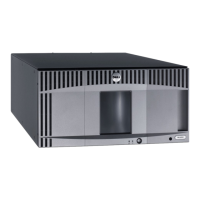Configuring Your Library
file:///T|/htdocs/stor-sys/ML6000/en/html/ch04.htm[9/17/2012 1:49:29 PM]
Details on network settings include:
• Library Name is the network name you want to assign to the library. The library name is limited to 12 lowercase
alphanumeric characters and dashes (-).
• DHCP defaults to enabled. When DHCP is enabled, the library obtains an IP address automatically. If DHCP is not
enabled, you must manually enter an IP address, default gateway, and subnet mask/net prefix.
• IPv4 addresses must be entered in dot notation (for example, 192.168.0.1). They are limited to numeric characters
and do not allow values exceeding 255 for dot-separated values.
• IPv6 addresses must be entered in the proper notation. IPv6 address can be entered in the most common notation,
as eight groups of four hexadecimal digits. 2001:0ff8:55cc:033b:1319:8a2e:01de:1374 is an example of a valid IPv6
address. Also, if one or more of the four-digit groups contains 0000, you can omit the zeros and replace them with
two colons (::), as long as there is only one double colon used in an address. Using this notation,
2001:0ff8:0000:0000:0000:0000:01de:1374 is the same as 2001:0ff8::01de:1374.
• IP Address is the IP address of the library. For IPv4, this text box is available only if DHCP is disabled.
• Default Gateway Address is the IP address of the default gateway for your portion of the Ethernet network. For
IPv4, this text box is available only if DHCP is disabled.
• Subnet Mask (IPv4 only). Text box is available only if DHCP is disabled.
• Network Prefix (IPv6 only).
• Primary DNS Address (optional, Web client only) must be entered as an IP address. This text box is available only if
DHCP is disabled.
• Secondary DNS Address (optional, Web client only) must be entered as an IP address. This text box is available only
if DHCP is disabled.
• Port Settings (operator panel only) allows you to change the autonegotiate mode, speed, and duplex settings on the
Ethernet port.
Caution: Modifying network settings will modify network connectivity parameters, requiring remote communication
configuration changes. Your current web client browser session might become invalid, requiring you to close your
current browser session. Access the Web client using the new network configuration settings and log in again.
Note: Be sure to add the PowerVault ML6000's IP address to the list of trusted/allowed sites on your PowerVault
ML6000-supported browser, so the Web client pages automatically refresh.
Note: For step-by-step network configuration instructions, see your library's online Help. To access the online Help
system, click the Help icon at the top right of the Web client or operator panel user interface.
The paths to open the appropriate screens are as follows:
• From the web client, select Setup > Network Management > Network.
• From the operator panel, select Setup > Network Mgmt.
Enabling SSL
Administrators can enable or disable SSL settings on the library. Enabling SSL settings encrypts all Web browser connections
to the Web client, and it enables SSL-based authentication for SMI-S. SMI-S is the newest standard of SNMP, which makes
sets of data continuously available. SMI-S is disabled by default. You can enable SMI-S on the Tools > System Settings
screen on the operator panel.
The default SSL setting is Disabled. Disabling SSL settings creates an unencrypted connection from a Web browser to the
Web client.
See the Dell PowerVault ML6000 SMI-S Reference Guide (document number HK592) for further configuration and access
details.
Note: Before enabling SSL settings, make sure you enter a name for the library in the Library Name text box when
configuring network settings (Setup > Network Mgmt on the operator panel). After enabling SSL settings, use that
library name to access the library. If you do not use that name, you will receive a security alert. In addition, make sure
to complete all the text boxes listed on the Web client Contact Information screen (Setup > Notification >
Contact Information) before enabling SSL settings. This information is used to identify company information in the
SSL certificate.

